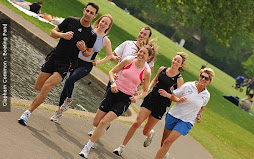Last Tuesday a few of us went along to hear about how we might optimise our Marathon training, hosted by Balance Physiotherapy. It was a pretty interesting evening, and I think each of us took away at least one new thing to think about when we train, even if we’re not all looking at marathons in 2011. Below I’ve used my (annoyingly incomplete) notes to summarise some of the main points of both lectures. Some will be more interesting/useful/relevant than others, but I hope they have been recorded faithfully and may be one or two of some interest to you.
Lecture 1, delivered by Raphael Rinaldi, on ‘how to prepare your first Marathon injury free’ was a little difficult to follow, but here’s what I picked up:
RUNNING STYLE: be sure to incorporate a torso twist/mobility of the trunk into your running; land on the balls of your and since your ankle receives the most impact when you run (followed by knee), it’s important to have very flexible ankles.
TRAINING: its very important to train to increase your ‘eccentric’ strength. ‘Eccentric’ muscle contraction is when you increase tension on a muscle when it lengthens, so in essence this means that you should train for endurance and stability goals in a way that involves different body areas. Circuits are ideal; with 8-10 stations, 1 min on each station and a minimum of 3 rounds of each station.
He talked about 3 TRAINING PHASES:
1. ADAPTATION – learning to run (applicable if you’re starting from scratch) (1-8 weeks)
2. RUNNING – learning to train – getting fit (9-16 weeks)
3. MARATHON TRAINING.
Underlying narrative: training is not about quantity, but quality. Don’t go out for a run to rack up the miles if you're feeling distracted/under the weather/unmotivated. Do something else instead.
Lecture 2 was given by Dr. Stewart Laing, a Sports Science Consultant at Balance. He seemed to know his stuff; having done several pieces of research into nutrition, including a full review of the relative effectiveness of all sports drinks on the market! *
In essence the aim of training is to improve the ability of your cardiovascular system to transport and deliver oxygen to your muscles, and then to optimise ability of your muscles to be able to use this oxygen. This involves improving your aerobic capacity (by running for longer) and your lactate threshold (by running harder).
To do the former you should try light sustained easy exercise – such as aerobics, light runs and for the latter, you need to do threshold runs, fartlek interval training – all of which are slightly different from one another but should push you into lactate burn and muscle fatigue because you’re at the point at which you shift from aerobic to anerobic activity. If training is effective, you’ll have shifted the point at which lactate begins to accumulate in your body.
NUTRITION: If you run a sub 2hr marathon, your body uses 3000 cals. Slightly less if its sub 4hrs. Ultimately the aim of training is to improve your body’s ability to use carbs and fat energy stores, and to shift the reliance of using carb stores onto fat stores. If you’re doing a run over 45 mins, you should refuel during the run using solid or liquid energy, as you prefer.
FLUIDS: dehydration is inevitable: you sweat around 4 litres in one marathon (1.2l/hour) and so would need to drink 200ml every 15 mins to prevent it. Since this isn’t possible, the next best option is to drink 200ml an hour (sip little and often) and to start hydrated before running. Its definitely wise to practise drinking like this during training to teach your body to tolerate this.
THERMOREGULATING: difficult here to get the right balance between over and under-dressing, especially in the winter. He recommends removing extra layers though as you begin to warm up, so you reduce the risk and negative consequences of overheating.
IMMUNE SYSTEM: some research indicates that moderate exercise increases the body’s immune system nicely, whereas high intensity exercise impairs it. When training for a marathon you’d be classified as doing the latter, so it follows that the risk of getting ill is greatly increased. You can mitigate this slightly by ensuring you don’t train when you’re feeling under the weather, and that you stay hydrated and don’t allow yourself to have a dry mouth. Saliva IgA protects against bacteria and viral infections but cannot be produced if you’re not taking on enough fluids.
*short answer: those with electrolytes, sodium and potassium
Check out performancesportservices.com for more information on this second lecture.
Subscribe to:
Post Comments (Atom)


No comments:
Post a Comment